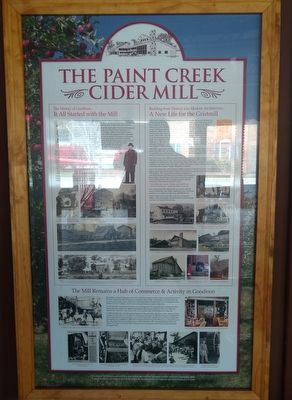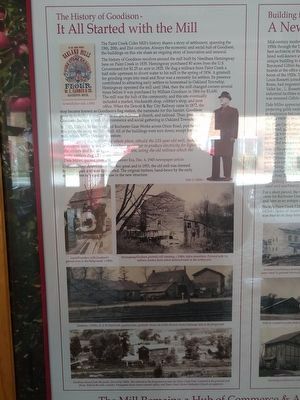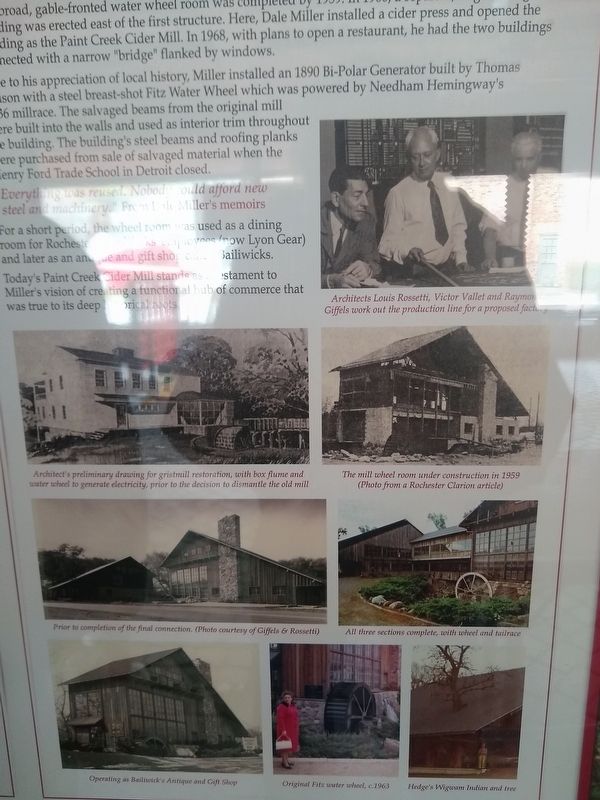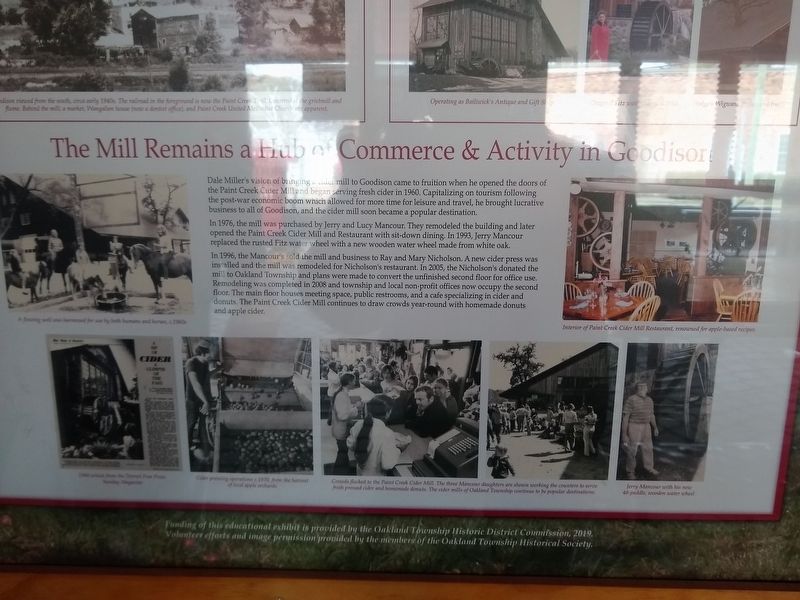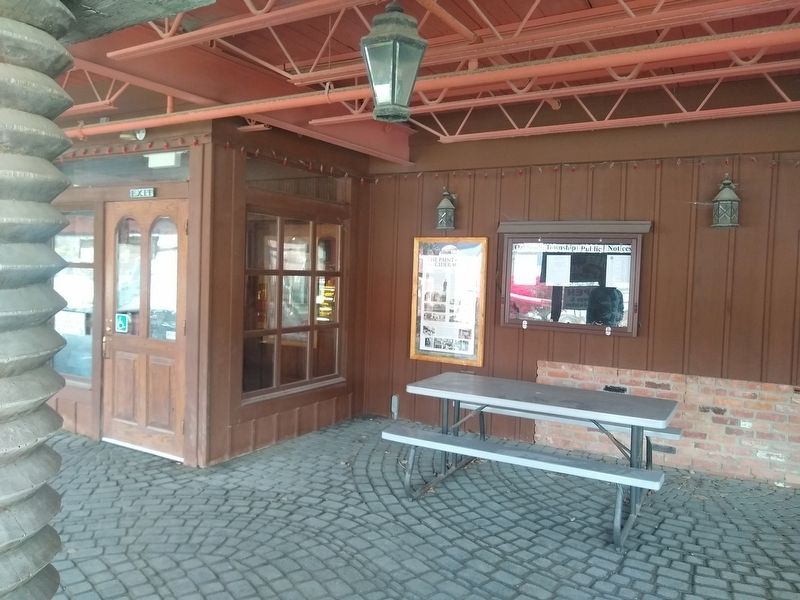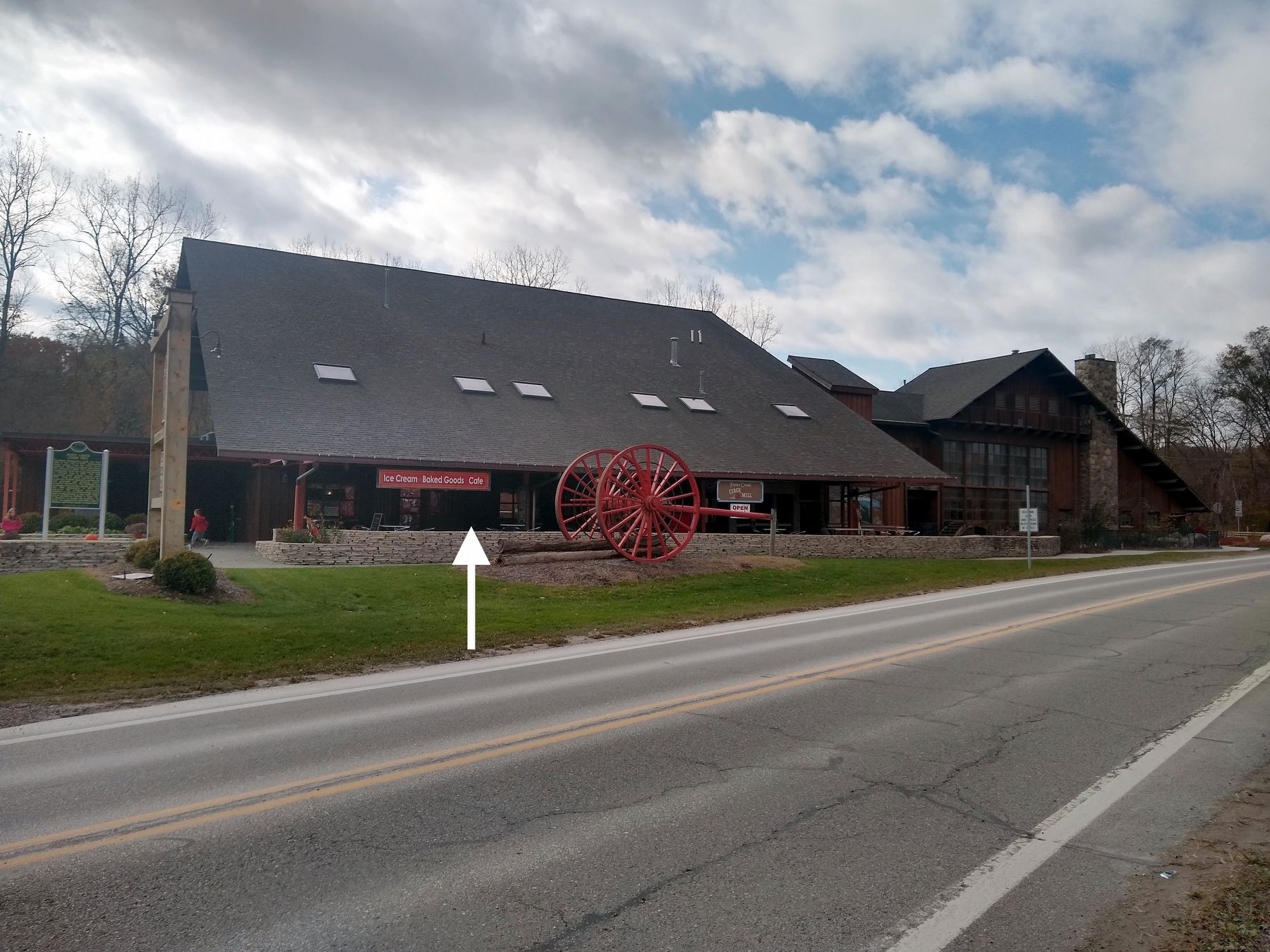Oakland Township near Rochester in Oakland County, Michigan — The American Midwest (Great Lakes)
The Paint Creek Cider Mill
The History of Goodison - It All Started with the Mill
The Paint Creek Cider Mill's history shares a story of settlement, spanning the 19th, 20th, and 21st centuries. Always the economic and social hub of Goodison, the buildings on this site share an ongoing story of innovation and renewal.
The history of Goodison revolves around the mill built by Needham Hemingway here on Paint Creek in 1835. Hemingway purchased 80 acres from the U.S. Government for $1.25 an acre in 1825. He dug a millrace from Paint Creek a half mile upstream to divert water to his mill in the spring of 1836. A gristmill for grinding crops into meal and flour was a necessity for settlers. Its presence contributed to attracting early settlers to homestead in Oakland Township. Hemingway operated the mill until 1844, then the mill changed owners several times before it was purchased by William Goodison in 1866 for $3,600. The mill was the hub of the community, and this site eventually included a market, blacksmith shop, cobbler's shop, and post office. When the Detroit & Bay City Railway came in 1872, the stop became known as Goodison's flag station, the namesake for this hamlet. Goodison grew to include a sawmill, more shops, schools, a church, and railroad. Thus, present-day Goodison became a center for commerce and social gathering in Oakland Township.
In 1945, Dale O. Miller, owner of Rochester Gear Works across Orion Road, purchased this property along with the mill. All of the buildings were torn down, except for the mill, which Miller planned to restore.
"We are going to clean up the whole place, rebuild the 125-year-old mill, install a modern water wheel and a modern generator to produce electricity for lighting the streets and buildings around Goodison, using the old millrace which the early settlers dug 125 years ago."
Dale Miller, quoted from The Rochester Era, Dec. 6, 1945 newspaper article
Unfortunately, deterioration was too great and in 1953, the old mill was deemed beyond repair and was dismantled. The original timbers, hand-hewn by the early settlers, were salvaged for reuse in the new structure.
Image captions
Top left: Gristmill flour sack, c. 1915
Top right: Dale O. Miller
First row left: Sawmill workers with Goodison's general store in the background, c. 1940s
First row right: Hemingway/Goodison gristmill still standing, c. 1940s, before demolition. Pictured with the millrace ... flume which delivered water to the turbine pits.
Second row: Goodison, c.1920s, (L to R) blacksmith, general store, gristmill. Notice the DUR (Detroit United Railway) rails in the foreground.
Bottom:
Goodison viewed from the south, circa early 1940s. The railroad in the foreground is now the Paint Creek Trail. Centered is the gristmill and flume. Behind the mill; a market, Wangalien house (now a dentist office), and Paint Creek United Methodist Church are apparent.
Building from History into Modern Architecture - A New Life for the Gristmill
Mid-century modern architecture is closely associated with the period between the 1950s through 1960s. The style appealed to everyone and the affluent hired the best architects of the day to design and build impressive buildings. Dale Miller hired well-known architects Giffels & Vallet, Inc., L. Rossetti Associates to design a unique building to attract people from all regions to Goodison. Victor Vallet and Raymond Giffels had worked together early in their careers over adjoining drafting boards at the office of renowned architect Albert Kahn in Detroit during the building boom of the 1920s. They left Albert Kahn to form their own company in 1925 and Louis Rossetti joined their firm in 1928. Rossetti, born in Paris in 1895 and trained in Rome, had migrated to Detroit in the 1920s. During the 1940s, the firm Giffels & Vallet Inc., L. Rossetti Associates, was instrumental in the conversion of many industrial facilities to wartime production. Vallet retired in January 1957 and the firm was renamed Giffels & Rossetti Associates.
Dale Miller appreciated the modernized version of traditional Swiss chalet architecture with its broadly projecting gable roofs, use of balconies, and extensive windows. The building's resulting design was Swiss in inspiration but contemporary in style; built using steel framing yet finished in traditional materials such as vertical board-and-batten and fieldstone.
The Paint Creek Cider Mill was built in three separate sections with construction spanning over a decade. The broad, gable-fronted water wheel room was completed in 1959. In 1960, a separate, larger side-gable building was erected east of the first structure. Here, Dale Miller installed a cider press and opened the building as the Paint Creek Cider Mill. In 1968, with plans to open a restaurant, he had the two buildings connected with a narrow "bridge" flanked by windows.
True to his appreciation of local history, Miller installed an 1890 Bi-Polar Generator built by Thomas Edison with a steel breast-shot Fitz Water Wheel which was powered by Needham Hemingway's 1836 millrace. The salvaged beams from the original mill were built into the walls and used as interior trim throughout the building. The building's steel beams and roofing planks were purchased from sale of salvaged material when the Henry Ford Trade School in Detroit closed.
"Everything
was reused. Nobody could afford new steel and machinery." From Dale Miller's memoirs
For a short period, the wheel room was used as a dining room for Rochester Gear Works' employees (now Lyon Gear) and later as an antique and gift shop called Bailiwicks.
Today's Paint Creek Cider Mill stands as a testament to Miller's vision of creating a functional hub of commerce that was true to its deep historical roots.
Image captions
Top row, right: Architects Louis Rossetti, Victor Vallet and Raymond Giffels work out the production line for a proposed factory.
Second row, left: Architect's preliminary drawing for gristmill restoration, with box flume and water wheel to generate electricity, prior to the decision to dismantle the old mill
Second row, right: The mill wheel room under construction in 1959 (Photo from a Rochester Clarion article)
Third row, left: Prior to completion of the final connection. (Photo courtesy of Giffels & Rossetti)
Third row, right: All three sections complete, with wheel and tailrace
Bottom row, left: Operating as Bailick's Antique and Gift Shop
Bottom row, middle: Original Fitz water wheel, c. 1963
Bottom row, right: Hedge's Wigwam Indian and tree
The Mill Remains a Hub of Commerce & Activity in Goodison
Dale Miller's vision of bringing a cider mill to Goodison came to fruition when he opened the doors of the Paint Creek Cider Mill and began serving fresh cider in 1960. Capitalizing on tourism following the post-war economic boom which allowed for more time for leisure and travel, he brought lucrative business to all of Goodison, and the cider mill soon became a popular destination.
In 1976, the mill was purchased by Jerry and Lucy Mancour. They remodeled the building and later opened the Paint Creek Cider Mill and Restaurant with sit-down dining. In 1993, Jerry Mancour replaced the rusted Fitz water wheel with a new wooden water wheel made from white oak.
IN 1996, the Mancour's sold the mill and business to Ray and Mary Nicholson. A new cider press was installed and the mill was remodeled for Nicholson's restaurant. In 2005, the Nicholson's donated the mill to Oakland Township and plans were made to convert the unfinished second floor for office use. Remodeling was completed in 2008 and township and local non-profit offices now occupy the second floor. The main floor houses meeting space, public restrooms, and a cafe specializing in cider and donuts. The Paint Creek Cider Mill continues to draw crowds year-round with homemade donuts and apple cider.
Image captions
Upper left: A flowing well was harnessed for use by both humans and horses, c. 1960s
Lower far left: 1962 article from the Detroit Free Press Sunday Magazine
Lower near left: Cider pressing operations c. 1970, from the harvest of local apple orchards
Lower middle and near right: Crowds flocked to the Paint Creek Cider Mill. The three Mancour daughters are shown working the counters to serve fresh pressed cider and homemade donuts. The cider mills of Oakland Township continue to be popular destinations.
Lower far right: Jerry Mancour with his new 48-paddle, wooden water wheel
Upper right: Interior of Paint Creek Cider Mill Restaurant, renowned for apple-based recipes
Funding of this educational exhibit is provided by the Oakland Township Historic District Commission, 2019. Volunteer efforts and image permission provided by the members of the Oakland Township Historical Society.
Erected 2019 by Oakland Township Historic District Commission.
Topics. This historical marker is listed in these topic lists: Architecture • Industry & Commerce • Settlements & Settlers. A significant historical month for this entry is January 1957.
Location. 42° 43.969′ N, 83° 9.732′ W. Marker is near Rochester, Michigan, in Oakland County. It is in Oakland Township. Marker can be reached from the intersection of Orion Road and Gallagher Road, on the left when traveling north. Marker is next to the cafe exit door. Touch for map. Marker is at or near this postal address: 4480 Orion Road, Rochester MI 48306, United States of America. Touch for directions.
Other nearby markers. At least 8 other markers are within 4 miles of this marker, measured as the crow flies. Water Wheel (within shouting distance of this marker); a different marker also named Paint Creek Cider Mill (within shouting distance of this marker); Paint Creek Millrace (within shouting distance of this marker); Forestry Mowing for Habitat Restoration (approx. half a mile away); Paint Creek Cemetery (approx. 1.3 miles away); Decker Settlement / Jesse Decker (approx. 2.9 miles away); The Oak Leaf (approx. 3.3 miles away); 1850 Red House (approx. 3.4 miles away). Touch for a list and map of all markers in Rochester.
Credits. This page was last revised on February 7, 2023. It was originally submitted on February 14, 2020, by Joel Seewald of Madison Heights, Michigan. This page has been viewed 321 times since then and 59 times this year. Photos: 1, 2, 3, 4, 5, 6. submitted on February 14, 2020, by Joel Seewald of Madison Heights, Michigan.
